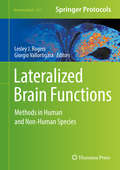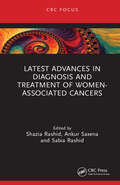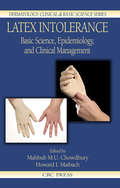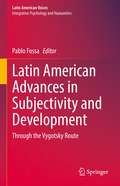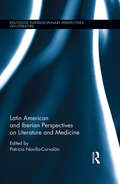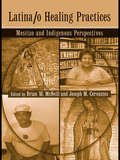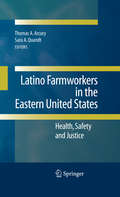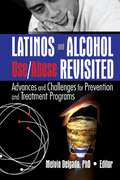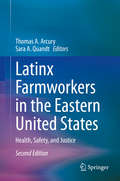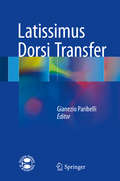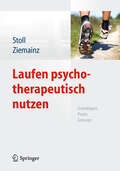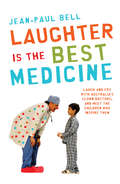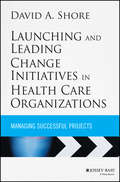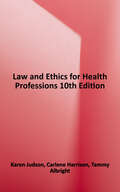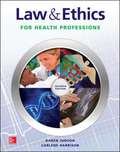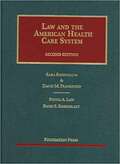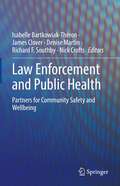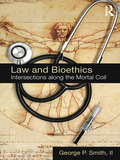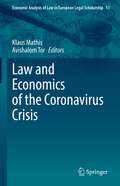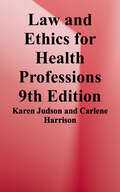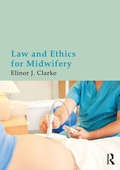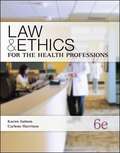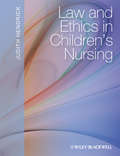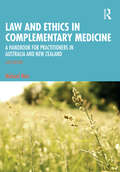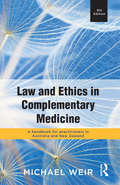- Table View
- List View
Lateralized Brain Functions
by Lesley J. Rogers Giorgio VallortigaraThis volume explores both simple and sophisticated techniques used in the study of different types of lateralization of brain and behavior. Research in this field increases our understanding of various brain functions in humans, other vertebrate species, and invertebrates. The book is divided into five parts: behavioral methods; neurobiological methods; electroencephalographic, imaging, and neuro-stimulation methods; genetic techniques; and development of lateralization. Part I addresses measuring lateralization by scoring behavior induced by inputs to one or the other side of the brain in a range of species. Part II covers neurobiological methods used to reveal lateralization, such as lesion studies, electrophysiology and pharmacology, early gene expression, and new optogenetic methods. Part III looks at imaging techniques, electroencephalographic techniques, and transcranial stimulation to reveal lateralization. Part IV describes techniques used to study the role of genes in the development and establishment of brain asymmetry in humans and other species. Lastly, Part V refers to methods used in the study of development of lateralization through the manipulation of sensory exposure, hormone levels, and in model systems. In Neuromethods series style, chapters include the kind of detail and key advice from the specialists needed to get successful results in your own laboratory. Cutting-edge and thorough, Lateralized Brain Function: Methods in Human and Non-Human Species is a valuable resource for investigating lateralization in a broad range of species and provides excellent advice for both new and veteran researchers.
Latest Advances in Diagnosis and Treatment of Women-Associated Cancers
by Dr Shazia Rashid Dr Ankur Saxena Dr FRCPath Sabia Rashid Mrcp, FRCPath Sabia Rashid MrcpThere has been tremendous progress in cancer diagnosis and treatment methodologies, and this book focuses on major cancers of the cervix, breast, endometrium, and the associated reproductive system affecting women. It focuses on specific diagnostic techniques and treatment strategies including computational tools, Nanomedicine, and the use of Machine Learning (ML), Artificial Intelligence (AI), Big Data, and other latest techniques, including the evolution of these treatments over the years. Oncologists, cancer scientists, and professionals will find using the content on cutting-edge interventions by experts in their field, significantly improving earlier diagnosis and treatment options. Key Features:• Helps to improve quality of life after treatment as the focus of healthcare is shifting from curative methods to primary prevention of diseases, screening methods and early detection and treatment.• Appeals to clinicians and residents interested in exploring cutting-edge technology for early diagnoses and treatment of women associated cancers.• Features a chapter on the Clinician’s perspective on advanced diagnostic and treatment methods.
Latex Intolerance: Basic Science, Epidemiology, and Clinical Management
by Howard I. Maibach Mahbub M.U. ChowdhuryThis comprehensive, definitive, and long overdue reference deals specifically with all the manifestations of latex intolerance including irritation, allergic contact dermatitis, and contact urticaria. Each chapter presents the latest research in skin irritation, contact dermatitis, and contact urticaria. The well-illustrated textbook also covers in
Latin American Advances in Subjectivity and Development: Through the Vygotsky Route (Latin American Voices)
by Pablo FossaThis is the first book in English to show how the work of Lev Vygotsky gave rise to a prolific and original school of cultural-historical psychology in Latin America. In recent decades, Latin American researchers have expanded Vygotskyan conceptualizations and applied practical theory to psychological and educational research and practice, but until now this production remained virtually unknown for English speaking audiences since it has been mainly published in Spanish and Portuguese. This timely volume contributes to change this situation by presenting a panoramic picture of the state of the art of cultural-historical psychology in Latin America. The book is divided in two parts. The first part shows how Latin American researchers used Vygotsky’s work to develop new theoretical elaborations and empirical advances to deal with different political, social and cultural problems in the region. The second part presents an overview of the current state of cultural-historical psychology in Latin America. Throughout its 15 chapters, the book shows how Latin American researchers contributed to the studies of different aspects of the cultural-historical theoretical conception of the development of higher psychological functions, such as concept formation, inner speech, zone of proximal development and imagination, and how these theoretical elaborations have been applied to research and practice in fields such as sociocultural psychology, developmental psychology, psychotherapy and education in Argentina, Brazil, Chile, Colombia, Cuba, Mexico, Peru and Puerto Rico.Latin American Advances in Subjectivity and Development - Through the Vygotsky Route will be an invaluable resource to researchers, students and practitioners in the fields of psychology, education and other social sciences interested in discovering or learning more about the original Latin American school of cultural-historical psychology.
Latin American and Iberian Perspectives on Literature and Medicine (Routledge Interdisciplinary Perspectives on Literature)
by Patricia Novillo-CorvalánThis is the first study to examine the representation of illness, disability, and cultural pathologies in modern and contemporary Iberian and Latin American literature. Innovative and interdisciplinary, the collection situates medicine as an important and largely overlooked discourse in these literatures, while also considering the social, political, religious, symbolic, and metaphysical dimensions underpinning illness. Investigating how Hispanic and Lusophone writers have reflected on the personal and cultural effects of illness, it raises central questions about how medical discourses, cultural pathologies, and the art of healing in general are represented. Essays pay particular attention to the ways in which these interdisciplinary dialogues chart new directions in the study of Hispanic and Lusophone cultures, and emerging disciplines such as the medical humanities. Addressing a wide range of themes and subjects including bioethics, neuroscience, psychosurgery, medical technologies, Darwinian evolution, indigenous herbal medicine, the rising genre of the pathography, and the ‘illness as metaphor’ trope, the collection engages with the discourses of cultural studies, gender studies, disability studies, comparative literature, and the medical humanities. This book enriches and stimulates scholarship in these areas by showing how much we still have to gain from interdisciplinary studies working at the intersections between the humanities and the sciences.
Latina/o Healing Practices: Mestizo and Indigenous Perspectives
by Brian W. McNeillThis edited volume focuses on the role of traditional or indigenous healers, as well as the application of traditional healing practices in contemporary counseling and therapeutic modalities with Latina/o people. The book offers a broad coverage of important topics, such as traditional healer’s views of mental/psychological health and well-being, the use of traditional healing techniques in contemporary psychotherapy, and herbal remedies in psychiatric practice. It also discusses common factors across traditional healing methods and contemporary psychotherapies, the importance of spirituality in counseling and everyday life, the application of indigenous healing practices with Latina/o undergraduates, indigenous techniques in working with perpetrators of domestic violence, and religious healing systems and biomedical models. The book is an important reference for anyone working within the general field of mental health practice and those seeking to understand culturally relevant practice with Latina/o populations.
Latino Farmworkers in the Eastern United States
by Sara A. Quandt Thomas A. ArcuryThey work at some of America's most hazardous jobs, have few protections, and receive some of the lowest wages. Latino Farmworkers in the Eastern United States describes this understudied and underserved population. Taking a social justice stance, this volume examines the health and living conditions of workers in agriculture, while advocating for equality. Contributors cover all major areas of illness and injury (including occupational, environmental, infections, and pesticides), while also focusing on systemic social conditions, from lax industry regulations to lack of basic services--problems that are exacerbated by workers' status as recent immigrants. Mental health burdens from the effects of discrimination to substance use, as well as the cumulative impact of workers' separation from families are discussed for a comprehensive, meticulously documented resource. Written to serve both the seasoned professional and the newcomer, Latino Farmworkers in the Eastern United States is a bedrock source of information for those providing health and social services in the community, for researchers investigating health and safety disparities, and for advocates and policymakers working to correct them.
Latinos and Alcohol Use/Abuse Revisited: Advances and Challenges for Prevention and Treatment Programs
by Melvin DelgadoThe one-of-a-kind exploration of effective alcohol prevention and treatment for Latinos-now and for the future!By the year 2020, the Latino population in the United States will increase to 60 million, making up 18 percent of all residents. Latinos and Alcohol Use/Abuse Revisited: Advances and Challenges for Prevention and Treatment Programs brings into sharp focus how present and future demographic shifts in Latino population are being felt in alcohol programs across the United States. Case studies and in-depth research clearly illustrate the practical steps various culturally competent programs recommend to effectively deal with alcohol use, prevention, and treatment for Latinos.Alcohol abuse, though rampant in Latino populations, has not received the attention that other types of drug abuse has received, even though the death rates, health problems, and financial costs from alcohol are staggering. Latinos and Alcohol Use/Abuse Revisited presents respected authorities tackling the tough questions about demographics, culturally competent research, and effective prevention and treatment programs. The book provides an up-to-date socio-demographic foundation, then builds upon current research and information to present a clear picture of the needs of various Latino populations for alcohol abuse programs now and in the future.Latinos and Alcohol Use/Abuse Revisited discusses: the Latino demographic profile-an overview patterns of need and treatment among Mexican-origin adults in central California alcohol abuse among Dominican-Americans the onset of alcohol and other drug use among gang members incarcerated Latinas, alcohol, and other drug abuse rural Latino grandparents raising grandchildren of substance abusing parents alcohol use among Puerto Rican active injecting drug users alcohol and other drug abuse prevention for high-risk youth a case study of a Puerto Rican community in Massachusetts detailed recommendations for prevention and treatmentLatinos and Alcohol Use/Abuse Revisited is a detailed examination of prevention and treatment programs for Latinos, invaluable for substance abuse professionals, social workers, practitioners, and professionals in charge of alcohol prevention and treatment programs.
Latinx Farmworkers in the Eastern United States: Health, Safety, and Justice
by Sara A. Quandt Thomas A. ArcuryMigrant and seasonal farmworkers are largely Latinx men, women, and children. They work in crop, dairy, and livestock production, and are essential to the U.S. agricultural economy—one of the most hazardous and least regulated industries in the United States. Latinx migrant and seasonal farmworkers in the eastern United States experience high rates of illness, injury, and death, indicating widespread occupational injustice. This second edition takes a social justice stance and integrates the past ten years of research and intervention to address health, safety, and justice issues for farmworkers. Contributors cover all major areas of health and safety research for migrant and seasonal farmworkers and their families, explore the factors that affect the health and safety of farmworkers and their families, and suggest approaches for further research and educational and policy intervention needed to improve the health and safety of Latinx farmworkers and their families. Among the chapter topics are:Occupational injury and illness in Latinx farmworkers in the eastern United StatesMental health among Latinx farmworkers in the eastern United StatesThe health of women farmworkers and women in farmworker families in the eastern United StatesThe health of children in the Latinx farmworker community in the eastern United StatesCommunity-based participatory research with Latinx farmworker communities in the eastern United StatesFarm labor and the struggle for justice in the eastern United StatesAccessibly written and comprehensive in its scope, this second edition of Latinx Farmworkers in the Eastern United States: Health, Safety, and Justice will find an engaged audience among researchers, students, and practitioners in public health, occupational health, public policy, and social and behavioral sciences, as well as labor advocates and healthcare providers.
Latissimus Dorsi Transfer
by Gianezio ParibelliThis book is exceptional in providing detailed state of the art guidance on all aspects of transfer of the latissimus dorsi tendon for indications including irreparable posterosuperior rotator cuff tears, irreparable subscapularis tears, and shoulder replacement. In addition to clear, well-illustrated descriptions of arthroscopically assisted surgical technique, readers will find helpful information on biomechanics, surgical indications, post-transfer rehabilitation, and complications and their management. Outcomes from individual studies and meta-analyses are evaluated, and a feature of special interest is the presentation of experiences and results in a series of more than 430 patients using the surgical technique first described by Enrico Gervasi more than 10 years ago. This technique involves modifications in both preparation of the footprint for the latissimus dorsi tendon and the biomechanical features of the tendon transfer and is very different from the procedure proposed by Christian Gerber. The book will be of high value for all orthopedic surgeons who perform this complex shoulder surgery, as well as for residents and fellows-in-training.
Laufen psychotherapeutisch nutzen
by Heiko Ziemainz Jasmin Braun Oliver Stoll Ina BlazekBreitensport für die Therapie nutzbar gemacht Joggen, Laufen und Walking scheinen eine hohe Akzeptanz zu haben. Inzwischen ist auch ihre therapeutische Wirksamkeit nachgewiesen. In diesem Buch werden neben Grundlagen auch die Besonderheiten in der Anwendung bei einzelnen Störungsbildern beschrieben. Außerdem wird solide auf Kontraindikationen und Grenzen hingewiesen. Grundlagen, Praxis und Grenzen Das Buch der Fachexperten Professor Stoll und Dr. Ziemainz, die selbst erfahrene Läufer sind, gliedert sich in drei Teile: Theoretische Grundlagen, Lauftherapie - praktische Empfehlungen; Grenzen von Lauftherapie bzw. von ausdauerndem Laufen; Praktische Schritte zur Lauftherapie, störungsbildbezogen. Therapeuten und Berater erfahren, wie sie schrittweise vorgehen. Einige Fragen: Wie kann ich als Therapeut oder Berater meinen Klienten animieren, Ausdauersport als Ressource auszuprobieren und möglichst dauerhaft in seinen Alltag einzubauen? Wie kann ich Laufen in der Gruppe einsetzen (z.B. in der Suchtbehandlung)? Welche Mythen gibt es, die so nicht zutreffen?Geschrieben für Psychotherapeuten und andere Fachleute, die den Nutzen von Laufen und Ausdauersport in der psychotherapeutischen Praxis einsetzen wollen, für den Berufsverband der Deutschen Sporttherapeuten DVGS (Deutsche Verband für Gesundheitssport und Sporttherapie), für Studierende der Psychologie und Sportwissenschaften und für interessierte Laien. Ein Buch, das motiviert und informiert, den therapeutischen Nutzen von Joggen, Laufen, Walking selbst anzuwenden
Laughter is the Best Medicine
by Jean-Paul BellYou see, I'm not really a doctor. Not a medical doctor, that is. I'm something a bit more unusual. I reckon I have the best job in the whole world - I'm a clown doctor.' Jean-Paul Bell Imagine being a child in hospital, away from the home and feeling sad, frightened, lonely or in pain. This is where the Clown Doctors step in to help with their own quirky style of 'medicine'. Join this very special troupe as they do their rounds in children's hospitals all over Australia, bringing laughter and joy to more than 100,000 patients and their families each year. Meet Dr B Loony and Dr Twang, Dr Know-It-All and others when they conduct their clown rounds through children's and emergency wards, intensive care, burns and oncology units, dispensing jokes and songs with skill and compassion. And always with the aim of helping families, hospital staff, and especially the children to forget their illnesses and fears for a while and return to a world that is about fun and play. Welcome to a day in the lives of the Clown Doctors, filled with special moments, courage, tears, smiles and laughter.
Launching and Leading Change Initiatives in Health Care Organizations
by David A. ShoreImplement change that fosters sustainable growth and better patient careHealth care projects depend on astute management of change. But more than anything else, they depend on leaders who pay attention, who understand the importance of starting right, and who know how to launch projects that succeed. If leaders can increase the percentage of successful projects, patients, and practitioners everywhere will be better off and so will the organizations that depend on these projects for innovation.In Launching and Leading Change Initiatives in Health Care Organizations: Managing Successful Projects. Author David A. Shore of the Harvard School of Public Health speaks directly to the health care leaders and managers who see the need for change, but keep encountering nearly insurmountable challenges. Through his research, Shore discovered that most implementation failures occur because of a poor launch, and that strengthening processes and operations during the early weeks of a new project is a key to continued success. The book covers issues like:The preliminary groundwork that cultivates a stronger launchSystematic and selective project selectionBuilding the team that accomplishes changeSkill-building and record-keeping systems that foster sustainable growthLaunching and Leading Change Initiatives in Health Care Organizations gives leaders and managers the practical, easy-to-implement ideas and methodologies to start and manage projects successfully.
Law & Ethics for Health Professions
by Karen Judson Carlene Harrison Tammy AlbrightLaw and Ethics for Health Professions explains how to navigate the numerous legal and ethical issues that healthcare professionals face every day. Topics are based upon real-world scenarios and dilemmas from a variety of health care practitioners.
Law And Ethics: For The Health Professions (7th Edition)
by Karen Judson Carlene HarrisonLaw and Ethics for the Health Care Professions illustrates the numerous legal and ethical issues that health care professionals face every day. The topics are derived from real-life experiences and dilemmas from a variety of health care practitioners. Through the use of Learning Outcomes, Key Terms, Ethics Issues, Chapter Reviews, Case Studies, Internet Activities, Court Cases, and Video Vignettes, students hear from health care practitioners in various locations throughout the United States as they encounter legal and ethical problems and situations. Students will practice critical thinking skills to decide how to resolve the real-life situations or theoretical scenarios, determine why the court made a particular ruling and decide how the issues are relevant to the health care profession they will practice.
Law And The American Health Care System, 2d (University Casebook Ser.)
by Sara Rosenbaum David Frankford Sylvia Law Rand RosenblattLaw and the American Health Care System (University Casebook Series) 2nd Edition
Law Enforcement and Public Health: Partners for Community Safety and Wellbeing
by Denise Martin Isabelle Bartkowiak-Théron James Clover Richard F. Southby Nick CroftsThe expanding remit of policing as a fundamental part of the public health continuum is increasingly acknowledged on the international scene. Similarly the growing role of health professionals as brokers of public safety means that the need for scholarly resources for developing knowledge and broadening theoretical positioning and questioning is becoming urgent and crucial. The fields of law enforcement and public health are beginning to understand the inextricable links between public safety and public health and the need to shift policies and practices towards more integrated practices. This book comes as a first, an utterly timely scholarly collection that brings together the views of multidisciplinary commentators on a wide range of issues and disciplines within the law enforcement and public health (LEPH) arena. The book addresses the more conceptual aspects of the relationship as well as more applied fields of collaboration, and the authors describe and analyze a range of service delivery examples taken from real-life instances of partnerships in action. Among the topics covered:Defund, Dismantle or Define Law Enforcement, Public Health, and Vulnerability Law Enforcement and Mental Health: The Missing Middle The Challenges of Sustaining Partnerships and the Diversification of Cultures Using Public Health Concepts and Metrics to Guide Policing Strategy and Practice Policing PandemicsLaw Enforcement and Public Health: Partners for Community Safety and Wellbeing is essential reading for a wide array of professions and areas of expertise in the intersectoral field of LEPH. It is an indispensable resource for public health and law enforcement specialists (practitioners, educators, scholars, and researchers) and training programs across the world, as well as individuals interested in developing their knowledge and capacity to respond to complex LEPH issues in the field, including public prosecutors, coroners, and the judiciary. The text also can be used for undergraduate and postgraduate university policing, criminology, sociology, psychology, social work, public health, and medicine programs.
Law and Bioethics: Intersections Along the Mortal Coil
by George P. Smith IIGeorge P. Smith, II is a leading figure in the world of medical law and ethics. During his long career he has addressed some of the most important issues in bioethics and has contributed much original thought to debates in the field. This book celebrates his contribution to scholarship in this area and brings together his key writings in bioethics. The chapters include previously published material which has been substantially updated to reflect recent developments in medicine and law. The book covers topics such as: human rights and medical law; the allocation of resources and distributive justice; ethical relativism; science and religion; and public health emergencies. Taken as a whole, this book examines the extent to which law, medicine, economics, and bioethics interact as synergistic vectors of force in shaping and setting both personal and public responses to the complexities of biotechnology, or what has been referred to as "The New Biology." All too often, past considerations of this topic have neglected to recognise the synergistic influences of law as a catalyst for codifying contemporary values into normative standards. Professor Smith reaches the conclusion that if traditional bioethical principles are to be seen as pertinent constructs for policy making, they must be broadened through the law of public health and Human rights. Law and Bioethics: Intersections along the Mortal Coil casts law as the pivotal force in bringing stability to the ongoing debates on how to maintain bioethical relevance in decision making and in so doing, it offers an excellent overview of the current bioethical issues in medical law considered in light of recent and ongoing technological developments in medicine. This book will be of particular interest to academics and students of Law, Political Science, Philosophy and Economics.
Law and Economics of the Coronavirus Crisis (Economic Analysis of Law in European Legal Scholarship #13)
by Klaus Mathis Avishalom TorThe coronavirus pandemic struck unexpectedly, posing unprecedented challenges around the world. At the same time, this crisis also offers a unique opportunity for reflection, research, and insight regarding this and similar global and domestic crises. There is much to be learned from analysing the effects of the crisis. It provides a chance for a fresh scholarly examination of important aspects of legal regulation, policymaking, and more. This volume pursues these questions from a broad range of Law and Economics perspectives and is divided into two parts. The first part examines the immediate impact of and responses to the coronavirus crisis, while the second explores the future possibilities that scholarly analysis of this crisis can offer. As to the immediate impact and responses, questions of compliance with regulations and safety measures, nudging and decision-making with regard to the coronavirus crisis are examined from the perspective of behavioural economics. In addition, the short- and long-term effects of various emergency policy responses on contract law are studied. Current issues and challenges like the regulation of internet platforms, excessive pricing, the right to adequate food, risk and loss allocation, as well as remote learning and examinations, which have been impacted, brought about, complicated or aggravated by the coronavirus crisis, are analysed in depth. Lastly, future possibilities in the areas of data access rights, economic instability and the balance between political-economic interests and social interests, patenting, food labels and open data are illustrated.
Law and Ethics for Health Professions
by Karen Judson Carlene HarrisonThis book explains how to navigate the numerous legal and ethical issues that health care professionals face every day. Topics are based upon real-world scenarios and dilemmas from a variety of health care practitioners. In the ninth edition, material has been revised to reflect the current health care environment. <p><p>As students progress through the text, they will get the opportunity to use critical thinking skills to learn how to resolve real-life situations and theoretical scenarios and to decide how legal and ethical issues are relevant to the health care profession in which they will practice.
Law and Ethics for Midwifery
by Elinor ClarkeLegal and ethical competence is a cornerstone of professional midwifery practice and an essential part of midwifery training. Law and Ethics for Midwifery is a unique and practical resource for student midwives. Written by an experienced midwifery lecturer, this text draws on a wide variety of real life case studies and focuses particularly on the core areas of accountability, autonomy and advocacy. Opening with two chapters providing overviews respectively of ethical theories and legislation, the book is then arranged thematically. These chapters have a common structure which includes case studies, relevant legislation, reflective activities and a summary, and they run across areas of concern from negligence through safeguarding to record-keeping. Grounded in midwifery practice, the text enables student midwives to consider and prepare for ethical and legal dilemmas they may face as midwives in clinical practice.
Law and Ethics for the Health Professions (6th Edition)
by Karen Judson Carlene HarrisonLaw & Ethics for the Health Professions, sixth edition, provides an overview of the laws and ethics you should know to help you give competent, compassionate care to patients that is also within acceptable legal and ethical boundaries. The text can also serve as a guide to help you resolve the many legal and ethical questions you may reasonably expect to face as a student and, later, as a health care practitioner.
Law and Ethics in Children's Nursing
by Judith HendrickLaw and Ethics in Children's Nursing is an important and practical guide on the legal and ethical spects of child healthcare that enables nurses to understand the legal and ethical principles that underpin everyday nursing practice. It explores the concept of childhood and children's rights, the extent to which their rights are upheld in a variety of settings, and the relationship between law and ethics and how they interact in resolving problems and dilemmas that commonly arise in practice.With case studies, learning outcomes and scenarios throughout, Law and Ethics in Children's Nursing places the care and treatment of children in a legal and ethical framework, and explores the way in which legal and ethical aspects of children's nursing differ from those of adults. It explores general principles such as autonomy and consent, confidentiality, accountability and negligence. It then goes on to look at specialist areas such as abortion, sterilisation, research, mental health, organ donation, child protection and death.
Law and Ethics in Complementary Medicine: A Handbook for Practitioners in Australia and New Zealand
by Michael WeirComprehensive, practical and reflective of the current Australian and New Zealand legislative framework and regulations, this unique textbook addresses legal and ethical issues across a broad range of traditional and complementary practices. The sixth edition of Michael Weir’s classic textbook: • explores legal and ethical issues in clinical relationships, and the role of codes of ethics; • provides practical guidelines for setting up and running a professional practice; • systematically outlines the various aspects of the law which impact on clinical practice, including legal obligations to clients, consumer legislation, complaints processes, and professional boundaries;• explains how to navigate professional indemnity insurance; • outlines the steps you need to take in setting up a professional practice from establishing a business name to dealing with employees; • discusses and provides examples of how to deal with tricky ethical issues in daily practice. This edition includes updated legislation, a review of relevant case law, recent developments in the Unregistered Practitioners’ Code of Conduct and evidence about misconduct and regulatory action, and more in-depth discussion of ethical concepts. This is an essential read for students and practitioners of complementary medicine.
Law and Ethics in Complementary Medicine: A handbook for practitioners in Australia and New Zealand
by Michael Weir'A valuable resource for those in clinical practice and students undertaking primary and secondary qualifications in the complementary medicine and therapy disciplines.' Caroline Smith, Professor, Complementary Medicine Research, National Institute of Complementary Medicine, Western Sydney UniversityComprehensive, unique and reflective of the current Australian legislative framework and AHPRA regulations, Michael Weir's Law and Ethics in Complementary Medicine remains the most widely used reference text in the field. A valuable handbook for professionals, students and researchers, the text addresses legal and ethical issues across a broad range of traditional, complementary and integrative practices.The text deals with legal and ethical issues in clinical relationships and provides practical guidelines for setting up and running a professional practice. Michael Weir systematically outlines the various aspects of the law which impact on clinical practice, including legal obligations to clients, consumer legislation and complaints processes, and professional boundaries. He explains how to navigate professional indemnity insurance, and the steps you need to take in setting up a professional practice from establishing a business name to dealing with employees. He also outlines the role of codes of ethics, and explores how to deal with tricky ethical issues in daily practice.This fifth edition is fully updated with in-depth treatment of the issue of ethical practice and professional decision making. It addresses recent changes in regulation and case law, including the development of the National Code of Conduct for Healthcare Workers and also now includes yoga and holistic counselling as modalities of complementary medicine.
